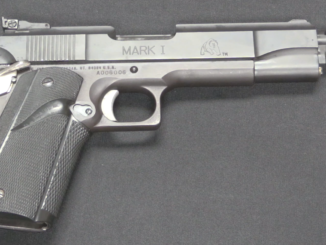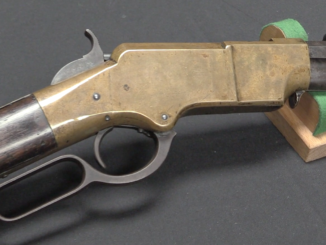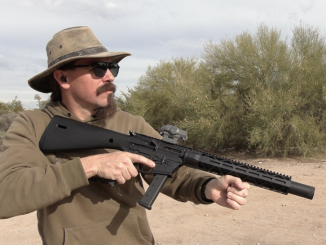Grant Hammond is best known (to the extent he is known at all) for a .45 caliber pistol submitted to US military trials in 1917 and 1918. This pistol is a proof of concept prototype embodying some of the concepts that would go into the later .45 caliber pistol, and also showing some concepts that would not see further use. This .32 ACP prototype features a hybrid blow forward / blowback mechanism in which the slide uses a gas trapping system to move forward and the bolt moves backward. It also has a unique system for automatically ejecting the magazine when empty. Truly one of the most mechanically unusual pistols I have ever seen.
Patents
US Patent 1138377 (Grant Hammond, “Firearm”, Jul 16, 1913)




As said in video – “ridiculously complicated”, but same time something to appreciate in sense how designer-inventor thought process has gone thru the task. Really, most amazing.
On construction side it is visible there are several layers of metal with mutual movement and in close contact. To expect this going in face of potential contamination risk is highly optimistic.
Pistol looks safest at the pressure management. It would be great if a simpler way to be found to make with same action basics. Extractor seems as missed.
You can use an inertia recoil system instead of the gas trap system. Therefore the forward movement of the unlocking piece retard the blowback action.
Hammond’s pistol seems having a “Long Recoil Loçked Breech” action with a reversed start. The reach of Barrel Shell to its foremost position as compressing its return spring via gas actuation, ends the motion of ballistic origin and following events occur in purely mechanical order. This nature brings the safest pressure management feature since there should be no residual gas within the gun when unlocking of brechbolt begins. There is no blowback action. The power drawing the breechbolt backwards comes from the compressed barrel cover return spring. An inertial action can not carry out such a long distance performance.
I don’t see any mechanism to hold the “energy store system” aka piston and spring in the forward position. Therefore when the gas pressure force < force of the spring, the system unlock the bolt and extract the case.
It's possible to increase the travel of this system (to retard the extraction) and still keep a good extraction by using a gas spring. But that's a fairly costly system compare to a pressure delay like the hk p7.
I found a simpler solution to retard the action while keeping the essence of this system.
I’ll post it after supper.
http://i19.servimg.com/u/f19/19/07/56/24/bfp10.jpg
Find how it works. 😉
Sorry late rebly. Your approach is realy intersting. Thanks posting it. However, if noticed, pistol’s breechbolt works through manual traction that is without gas power. This shows, there is a cammed or spring actuated extention of breechbolt taking the return spring compession to transit to the breechbolt. At a certain distance backward, it should be taken off of path of breechbolt. Thanks again for your interest.
Patent text page 3, lines70-130 also explains how breechbolt works.
Yes, but here, I replace the rotating bolt with a blowforward system. Since the barrel is hold while the bullet move through it (and I made a mistake in my drawing, I should have hold part #3 down since the beginning of the action) ; the piston and spring system acts both as pressure regulated unlocking and an energy storing system. There’s a traction spring to move the barrel forward when #2 move backward due to a compression spring.
Details need extra care. If ignored, they may terminate the basis. I have lived it several times in the past and sure repeat in the future.
Yes, especially when you work alone.
How many parts make up that pistol? I’m a 1911 guy, and that one was over built in my opinion.
“How many parts make up that pistol?”
I would rather ask: how many machine-hours or machine-operations was needed to manufacture it.
Not sure if “mechanically unusual” is a compliment, an insult or a simple statement of fact. I used to work with a guy who could “fine-tune” any simple two-hour task into a very inefficient 6-hour Charlie Foxtrot… looks like something he would have designed.
It reminds me of some over-engineered 1920s and 1930s sub-machine guns, especially Polish «MORS» sub-machine gun
https://www.forgottenweapons.com/submachine-guns/wz-39-mors/
My suspicion, as in many other cases, is that creator was not “ingeniuer’ in true sense of the word http://fr.wikipedia.org/wiki/Ing%C3%A9nieur – but rather inventive mechanic.
That by itself is accomplishment as one of most recognized of them – the great J.M.B. is in that category; mentioned title is denoting respect more than fact of academic achievement. Engineers usually tackle problems with most rudimentary way conceivable.
As a sample of later category I’d mention Fedor Vasilyevich Tokarev, the man who took Browning design to higher level of simplicity and manufacturing efficiency. That is what I call ‘engineering’ as opposed to ‘inventing’.
I first read that as “Mechanically unusable”.
Considering the self ejecting mechanism is partially built into the magazine, it wouldn’t be to hard to adapt this into other pistols would it?
My only tweak would be to be to add a heal release (for the sake of mechanical simplicity), that can can be engaged in order to turn the auto eject ‘off’ if you want it for normal operation (or regular mags) or disengage the release for ‘rapid fire’ – not sure if there’s a practical scenario for that, but could be a fun option to add to another design.
Possible, but tactically unsound. Rather like the infamous “M1 Garand Ka-CHANGG!!” when the empty en bloc clip is punched out, the unmistakeable sound of the magazine going out would tell the other guy you were trying to reload as fast as you could.
There’s a reason Cooper always taught to never use an automatic with a magazine safety, and to never get caught with an empty chamber in an IA. When the last round is up the spout, that’s when you change magazines.
Also note that on this one, there is no way to change a partly-empty magazine out for a full one during a lull in the action. While not that critical in a concealed-carry piece, which is unlikely to discharge more than one or two rounds in an encounter, it’s a serious handicap in a duty pistol.
cheers
eon
I have my doubts that in the heat of battle surrounded by the sounds of gunfire, possibly artillery, armor and aircraft the “ping” an M1 makes would be discernible to an enemy.
But this would be a great subject for a test video.
Most amusing when in recent video about Radium everything was done to not have a magazine to loose and here even more effort is put to unsure it’s to be lost…
I have impression that Grant Hammond design his fire-arm so he can say “my automatic pistol is more automatic that your!”
If you were in the middle of a street battle, I think a rapid reload would be appreciated, especially if a bad guy is coming your way with a knife… Maybe Hammond anticipated that nasty part of urban warfare?
If that were so, it would more probably have had a double-stack magazine like the Savage .32’s 10-round one.
At that time, the only pistols that held more rounds than the Savage was the German Parabellum P.08 with the 32-round Trommelmagazin 08, or the prototype Mauser “Broomhandle” 2-shot version. Both of which were larger and heavier than the Savage or this one.(Of course being 9 x 19mm and 7.63 x 25mm respectively, they were more powerful, too.)
The one that ended the argument was the Browning P-35 with a 13-shot magazine and 9 x 19mm hitting power. And BTW, it was pretty much ready for production by 1929, but the Depression held things up at FN for six years.
cheers
eon
“hybrid blow forward / blowback mechanism in which the slide uses a gas trapping system to move forward and the bolt moves backward.”
Russian SN (Savin Norov) fast-firing aircraft machine gun also has both forward-moving barrel and backward moving bolt. It was developed by И. В. Савин and А. К. Норов in 1935, it can fire up to 2800…3000 rpm, official name was «7,62-мм скорострельный авиационный пулемет обр. 1937 г. системы Савина – Норова», it was armament of I-16 type 19, three planes were build and used during Talvisota, Savin-Norov machine gun were mounted in wings.
source: http://www.airbase.ru/alpha/rus/s/sn/
So, when did ideas like “you sometimes have to unload the gun for various reasons” and “a kind of ordinary everyday person has to be able to clean it” gain wide currency?
A gun that literally cannot be unloaded in a design way? (Correction – I guess you could manually cycle the slide until all the rounds popped out onto the floor….)
Truly cool. Glad I don’t have to make one run.
Magnificent, in a Rube Goldberg kinda way. Does make the Frommer Stop seem a simple .32, yeah?
Exactly, my thought!
Things can be always made little more fancy, given dose of ‘rightly applied’ imagination.
This pistol reminds me a bit of the Dyson vacuum cleaner finding solutions to problems don’t necessarily exist, yet I still find this pistol to be fascinating.
Magnificent design, I am sure with hindsight all it needed in .45acp for proper functioning was tactical Hungarian sponge bob square pants tape which hadn’t made it past the Danube at the time of course.
Being unable to quickly unload a gun seems rather undesirable to me. I can see why this automatic mag ejecting idea didn’t catch on.